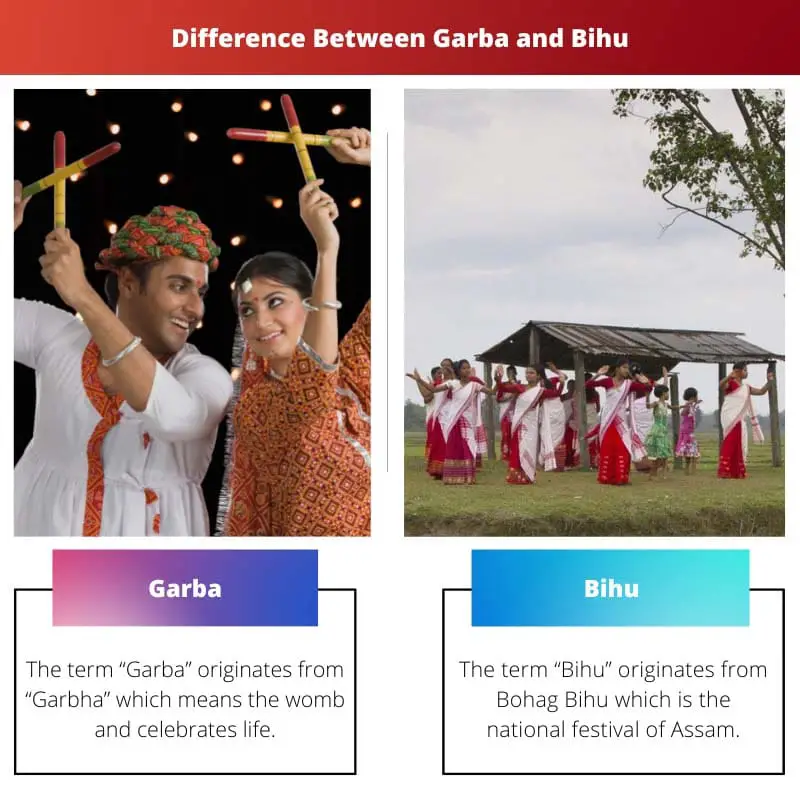Garba and Bihu are both dance forms that are restricted to two geographical locations. One comes from Gujarat, and one from Assam.
Both of the dances are quite popular, and everyone all over the Indian subcontinent knows their name because of the wide media coverage and the fact that they are covered extensively by soap operas.
Key Takeaways
- Garba is a traditional Gujarati dance form, while Bihu is an Assamese folk dance.
- Garba is performed during the Navratri festival, whereas Bihu is associated with the Assamese New Year and harvest season.
- Both dances showcase vibrant costumes, lively music, and energetic movements, celebrating cultural heritage and community.
Garba vs Bihu
Garba is a form of dance from the Gujarat region of India that is performed during the festival of Navratri, involving rhythmic steps, claps, and spins. Bihu is a folk dance from Assam, performed during the festival of Rongali Bihu, characterized by brisk steps, rapid hand movements, and a rhythmic swaying of hips.

Garba is a dance form that originated in Gujarat, located in the western part of the Indian subcontinent. It is heavily influenced by Dandiya Raas, which is only restricted to men and takes place during Navaratri, the celebration of nine nights-one of the biggest festivals, celebrated all over India.
On the other hand, Bihu is a dance form that originated in Assam, located in the northeastern part of the Indian subcontinent.
It is performed during a set of three festivals which also go by the same name and which are celebrated during the months of January, April, and October.
Comparison Table
| Parameters of Comparison | Garba | Bihu |
|---|---|---|
| Location of Origin | This dance form originated in Gujarat. | This dance form originated in Assam. |
| Time of Performance | It is performed in October. | It is performed in April. |
| Meaning | The term “Garba” originates from “Garbha” which means the womb and celebrates life. | The term “Bihu” originates from Bohag Bihu which is the national festival of Assam. |
| Dress | Women wear Chaniya and Choli while men wear ghagra and kafni pyjamas. | The women wear Mekhala and chaddar while the men wear dhoti. |
| The dance celebrates | The dance celebrates Durga who is the representation of the feminine form of divinity. | The dance celebrates seasonal fertility and passion. |
What is Garba?
Garba, which originates from the Sanskrit term “Garbha”, which means womb and celebrates life, is performed around a clay lantern with a light called “Garbha Deep”, which literally translates to womb lamp.
The lantern represents life. This dance thus honours Durga, who is the feminine form of divinity. It is performed in a circle which represents the Hindu view of time.
The dance is done to honour the fact that all humans have divinity or the energy of the Devi inside them. This is a high-energy dance, and both men and women wear very colourful costumes while performing this dance.
The style of this dance varies from place to place, all over Gujarat. The traditional colours worn during this dance are either red, pink or orange. Heavy jewellery is also worn by women who take part in this dance.
The dandiya sticks, which have been taken from Dandiya Raas, are made of wood. Men wear pyjamas or dhotis with kurtas which are ethnically referred to as Kedia.
They also wear pieces of jewellery such as oxidised bracelets and necklaces. They are also celebrated in the United States of America, which boasts of a large Gujarati population.

What is Bihu?
Bihu is an indigenous folk dance that originates from the state of Assam and is related to the festival of the same name. The festival is the national festival of Assam and goes by the name of Bohag Bihu or Rangali Bihu.
This festival celebrates the Assamese New Year. It takes place during the middle of April, and the date sometimes coincides with the Bengali New Year.
The origination of this dance is, however, known, but it can be said without any doubt that the dance originated from the diverse ethnic groups who reside in Assam.
Mostly young men and women take part in this dance. The men play musical instruments like the drums, popularly known as dhol, horn-pipes and flutes. The women dance.
There are some variations to this dance in which both men and women participate in this dance. Even though it served as a courtship dance in earlier times, it no longer serves that purpose.
It is a symbol of the cultural identity of Assam, even though the colonial rulers looked down upon it because of its erotic nature. Even though indigenous, the dance has managed to stay relevant in the age of urbanisation.

Main Differences Between Garba and Bihu
- Garba celebrates the Hindu concept of time, while Bihu celebrates the indigenous concept of fertility.
- In Garba, both men and women dance, while in Bihu, only the women dance, and men play various instruments.
- People who perform Garba wear colourful outfits, which are yellow, pink or orange, but people who perform Bihu wear only earth tones or white accompanied with red.
- Both men and women wear heavy jewellery during Garba, but in Bihu, no one wears heavy jewellery.
- Dandiya Raas influence Garba, while indigenous dances influence Bihu, but the immediate dance of origin is not known.

